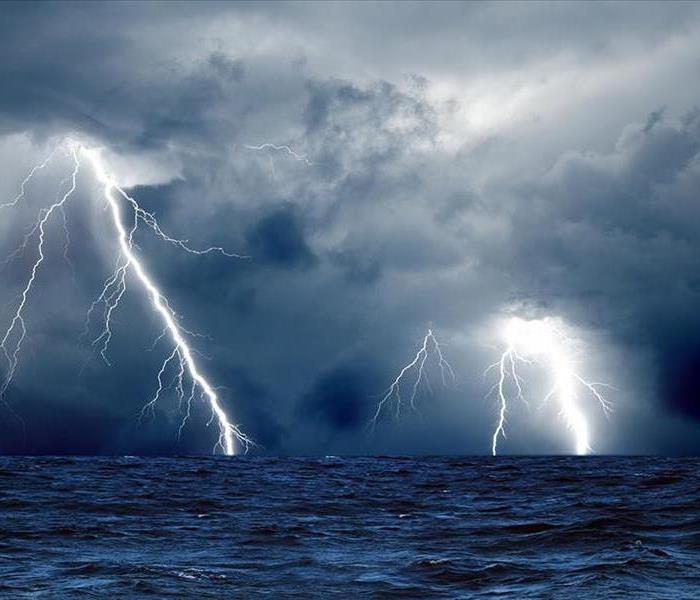Storm Ready
9/2/2016 (Permalink)
Storm Basics
A thunderstorm is a rain shower during which you hear thunder. Since thunder comes from lightning all thunderstorms have lightning. A thunderstorm is classified as "severe" when it contains one or more of the following:
- Hail
- Winds in excess of 58 mph
- Structural wind damage
- Tornado
Tornado Facts
Tornadoes are arguably nature's most violent storms. Generated from powerful thunderstorms, tornadoes generally appear as rotating, funnel-shaped clouds extending from the cloud base to the ground. With winds that can reach up to 300 miles per hour, tornadoes can cause massive destruction within seconds. Damage paths can be in excess of one mile wide and fifty miles long.
- The average tornado moves southwest to northeast, but tornadoes have been known to move in any direction..
- The average forward speed of a tornado is 30 miles per hour, but may vary from stationary to 70 miles per hour
- Tornadoes can accompany tropical storms and hurricanes as they move onto land.
- Tornadoes are most frequently reported east of the Rocky Mountains during spring and summer months.
- Tornadoes are most likely to occur between 3pm and 9pm
Hurricane Facts
A hurricane is an intense tropical storm with powerful winds and heavy rain
Other names for a hurricane include cyclone, typhoon and tropical storm. While they are essentially the same thing, the different names usually indicate where the storm took place. Tropical storms that form in the Atlantic or Northeast Pacific (near the United States) are called hurricanes, those that form near in the Northwest Pacific (near Japan) are called typhoons and those that form in the South Pacific or Indian oceans are called cyclones.
Hurricanes usually form in tropical areas of the world.
Hurricanes develop over warm water and use it as an energy source.
Hurricanes lose strength as they move over land.
- Coastal regions are most at danger from hurricanes.
- As well as violent winds and heavy rain, hurricanes can also create tornadoes, high waves and widespread flooding.
- Hurricanes are regions of low atmospheric pressure (also known as a depression).
- The wind flow of hurricanes in the southern hemisphere is clockwise while the wind flow of hurricanes in the northern hemisphere is counterclockwise.
- Flood rank as one of the most common and widespread natural disasters in the United States. Whether you live near a coastline, along city streets, in the mountains, near a river or even in the desert, there is a potential for suffering flood damage.
Before the storm
- To begin preparing, you should build an emergency supply kit and make a family communication plan.
- Remove dead or rotting trees and branches that could fall and cause injury or damage during a severe thunderstorm.
- Postpone outdoor activities
- Remember the 30/30 Lightning Safety Rule: Go indoors if, after seeing lightning, you cannot count to 30 before hearing thunder. Stay indoors for 30 minutes after hearing the last clap of thunder.
- Secure outdoor objects that could blow away or cause damage
- Get inside a home, building, or hard top automobile. Although you may be injured if lightning strikes your car, you are much safer inside a vehicle than outside.
- Remember, rubber-soled shoes and rubber tires provide NO protection from lightning. However, the steel frame of hard-topped vehicle provides increased protection if you are not touching metal.
- Shutter windows and secure outside doors. If shutters are not available, close window blinds , shades or curtains.
- Unplug any electronic equipment well before the storm arrives
During the Storm
- Use your battery-operated NOAA Weather Radio for updates from local officials
- Avoid contact with corded phones. Use a corded telephone only for emergencies
- Avoid contact with electrical equipment or cords. Unplug appliances and other electrical items such as computers and turn off air conditioners. Power surges from lightning can cause serious damage
- Avoid contact with plumbing. Do no wash your hands, do not take a shower, do not wash dishes, and do not do laundry. Plumbing and bathroom fixtures can conduct electricity.
- Stay away from windows and doors, and stay off porches.
- Do no lie on concrete floors and do not lean against concrete walls
- Avoid natural lightning rods such as a tall, isolated tree in an open area.
- Avoid hilltops, open fields, the bench or a boat on the water.
- Take shelter in a sturdy building. Avoid isolated sheds or other small structures in open areas.
- Avoid contact with anything metal-tractors, farm equipment, motorcycles, golf carts, golf clubs, and bicycles.
- If you are driving, try to safely exit the roadway and park. Stay in the vehicle and turn on the emergency flashers until the heavy rain ends. Avoid touching metal or other surfaces that conduct electricity in and outside the vehicle.
After The Storm
- Never drive through a flooded roadway.
- Stay away from storm-damaged areas to keep from putting yourself at risk from the effects of severe thunderstorms
- Continue to listen to a NOAA Weather Radio or local radio and television stations for updated information or instructions, as access to roads or come parts of the community may be blocked.
- Help people who may require special assistance, such as infants, children and the elderly or those with access or functional needs.
- Stay away from downed power lines and report them immediately.
- Watch your animal closely. Keep them under your direct control.






 24/7 Emergency Service
24/7 Emergency Service